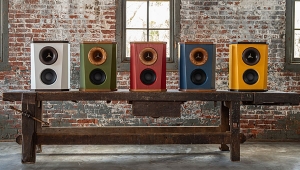| Columns Retired Columns & Blogs |
Gordon Rankin, Wavelength's Single-Ended Man
Jonathan Scull: Gordon, please tell us what you see as the basic difference between single-ended and push-pull.
Gordon Rankin: Well, first let me tell you that we actually used to build push-pull amps—they were EL34-based units—for a good five years before we tried our first single-ended amplifier. In any case, as a musician I would say the detail of the output of a single-ended amp seemed more pure and less distorted in some ways.
Scull: How did you get single-ended, Gordon?
Rankin: I'd gotten a pair of single-ended transformers and a bunch of tubes from a kid at the University of Cincinnati, and in there were single-plate 2A3s—they're very hard to find. I wired up a simple single-ended amplifier and listened in mono. Surprisingly, I found the sound was more exact. Its presentation was more true of a live performance. I guess in engineering terms you could say there are a lot of reasons why one is always better than two, two better than four, and so on. In fact, not having to worry about splitting the phase and integrating it into the output stage has a big impact on the sound too. And of course push-pull cancels even-order distortion. But in the end, push-pull just didn't seem as natural and balanced-sounding to me as single-ended.
Scull: You're saying that having both odd- and even-order distortion products in the output is an important aspect of single-ended's sound?
Rankin: You know, distortion is a part of life. The reproduction of sound will always include distortion products—both even- and odd-order. Any type of reproducing device will exhibit distortion in its output. And canceling even some of it can have a detrimental effect to the sound itself as a whole.
Scull: Gordon, can you describe your circuit for us?
Rankin: Sure, all our amplifiers are made up of only two stages. If we could do it with one stage, we'd do it! We use the 6SL7 family in the Cardinal series as the front-end driver and gain tube in an SRPP circuit—that's shunt-regulated push-pull.
Scull: The input stage is push-pull?
Rankin: Yes, that's right. Actually it's both the input and gain stage, so we consider that a single stage. Then you have the 300B, which is the output stage. We did some engineering on it, and implemented certain things differently than in some other designs, but the Cardinal's input is primarily an SRPP circuit.
Scull: What's the difference between the special edition XS version and a standard Cardinal?
Rankin: Let me tell first you what's the same. The standard Cardinal has silver input wire and primarily the same resistor complement as the XS. The output wires are standard in both, and the power transformer itself is pretty much copper-oriented in both.
Scull: Uhhh, yeah, but how do they differ, Gordon?
Rankin: Well, the regular Cardinal has an all-copper primary. The Cardinal XS has an output transformer that's a mixture of 20% silver and 80% OFC copper. I'd also played around with Siltech cables, especially their chassis hookup wire, and that stuff is really nice—probably the best internal hookup wire I've found to date. So we wired the Cardinal XS with Siltech and Kimber.
Scull: Why both?
Rankin: The Siltech is such a heavy gauge of silver that in some places I had to use the more flexible Kimber—the KCAG—a 20-gauge seven-strand design.
Scull: Lets's talk input tubes for a bit.
Rankin: Sure. There's about 100 different 6SL7s, like those manufactured by Sylvania, RCA, some European brands like ECC35s, and CV 569s. Philips bought Sylvania in '85 or '86, you know. But the tubes I've felt the happiest with are the Sylvanias. Matter of fact, in my opinion, the Sylvania tubes in the 6SL7 and the 6SN7 family have done the best job. We ship the Sylvania 6SL7WGT in the standard Cardinal, but you can also have the 6188, which is actually a 6SU7. The difference between them is that the two sides—it's a twin-triode—are heavily matched in a 6SU7, but everything else is pretty much the same as a 6SL7. But the 6188s are actually a little different. The plate impedance of a 6SL7 is roughly 50k ohms, but the 6188 is more like 25k ohms, and so it's got a better drive capability. It's an extremely nice tube—detailed and very fast. Because of the low plate impedance and high gain, it drives the 300B better than any other 6SL7 we've ever tried, including the 5691.
Scull: When ordering a Cardinal, do customers have the choice of input tube?
Rankin: We're shipping with the Philips Sylvania 6SL7WGT on the standard Cardinal, but we're pretty relaxed about it. We provided some of those hard-to-get 5691s for a long time. Fortunately they're much easier to find now. The US Government freed up an enormous supply of them recently. They finally figured out they had all these tubes lying around that they were unlikely to ever use. I just heard that Mike Matthews at New Sensor picked up 5000 6188s, and Steve at Angela Instruments has 5000 of the 5691s.
Scull: And with the XS?
Rankin: Then you have a choice of anything we have. Typically we sell them with the Mullard 5AR4 rectifier tube, which is branded by Sylvania and RCA. Almost everybody rebranded that tube because nobody made it better. Then there's a choice of input tubes between the 6188, or, for a more lush sound, they can have the 6SL7WGT.
Scull: Or for greater lushment, the RCA red-base?
Rankin: Yup, the red-base 5691 or, getting back to a more neutral sound, you can have the black-base Sylvania 5691. I prefer the 6188. Of the 5691s, I like the Sylvania better than the RCA, because the RCA gives a more rounded, slower sound. The Sylvania sounds much faster.
Scull: Moving to the output stage, let's talk 300Bs.
Rankin: Okaaaay. The standard issue for the Cardinal XS is the VAIC, and it's a very nice tube for a number of reason. Just by the feel and texture of the tube—its heavy base and glass—you can tell they've spent a lot of money in the design and construction. We also offer the Cardinal XS at a reduced price with the Golden Dragon 300B Super. When you're talking 7 or 8W, the output tube can make a difference of a couple of watts! The VAIC VV30B actually adds 1.5 or 2W without changing a thing—no biasing, no nothing. You just drop it in.
Scull: Speaking of biasing, how's it done in your amps?
Rankin: We do self-bias with all our tube amplifiers because we feel that the bass response is a lot faster and more realistic like that.
Scull: You prefer that scheme to fixed biasing?
Rankin: Yes, for fixed-biasing you need to supply a negative voltage, and you've got to use a meter to set it. Self-biasing uses a simple resistor on the tube—as more current passes through it, the voltage increases and therefore the tube biases itself. This actually helps in the area of clipping and low-frequency response. You see, when you fix-bias an amplifier, the tube becomes a lot harder to drive. You're driving the input to the tube, and you're driving the negative supply.
Scull: What about overall capacitance?
Rankin: Well, we use a Pi filter, which means you can get away with very low total capacitance. I don't believe in huge caps—it slows down the sound. In the Cardinal we use no more than 80µF of capacitance.
Scull: Since your amps are pure single-ended, let me ask how you feel about parallel 300Bs.
Rankin: I actually used to make an amplifier called the Twin, and that was a parallel single-ended amp. We came out with it because for a while our customers were using speakers that the Cardinal, at 7½ to 9W, just wouldn't drive. While I was designing and prototyping the Twin I noticed that at some point one of the tubes in the pair starts to take over. So you get this shearing effect—one tube will only be driving about 20% of the time, and the other in the pair will take over the rest of the job. You know, you can never truly match a set of tubes perfectly. They're mechanical devices, after all. Within the tolerances that you're looking for in the solid-state world, it would take 1000 to 2000 tubes before you'd get even two to work the same!
Scull: So parallel 300Bs need perfect matching?
Rankin: Yes, because you're driving one side of the transformer with both tubes. That's also why parallel 300Bs are more expensive—you've got more driver tubes and circuitry, and more stages overall. But a number of people who'd bought the Twins went for more sensitive speakers and switched to Cardinals. They've understood that straight single-ended actually works better than parallel 300Bs.
Scull: What do you hear as the differences between the two 300B circuit implementations?
Rankin: Parallel 300Bs are great for dynamics, but you lose a little of the clarity and information in the midband. You can hear this easily at louder listening levels. Of course, by then you may not care—maybe you're not listening carefully while you're cleaning or gallivanting around the house. But when you sit down to listen, it's very apparent. In general, parallels just don't sound as lush as single-ended.
Scull: So you're convinced that 7½ to 9 big ones are all it takes to make music?
Rankin: Yes, in fact the first amp we ever built was with the 845—you know, the big transmitter tube. I'd designed push-pull amps for years, so I also thought that you had to have the watts. That amp had a 6SL7 driving a 300B driving an 845! We don't make it now because they weighed 85 lbs each and actually took over 400 hours of my time to build. But the big transmitter tubes were great in the mid- and low bass. They're perfect for subwoofers—the 211s and 845s are the best things in the world for that. They have a real driving force because of their extremely high voltage. It just takes home the cows!
Scull: [laughs] Tell me, Gordon, how long have you been taking home the cows?
Rankin: We've been a business since 1981. We were building speakers back then when I graduated college with a degree in Electrical Engineering. I have degrees in music and physics as well. Building speakers was hard to do and time-consuming—matching drivers and so on. If we had the desktop computing power we have now back then, I'd probably still be designing speakers today!
Scull: So, Gordon, can a push-pull audiophile find happiness with single-ended triodes?
Rankin: I think so, I mean, I did—I was transformed!
Scull: Was that transformed or transformered, Gordon?
Rankin: [laughs]
Scull: Any last thoughts?
Rankin: Yeah. Always have fun, don't buy compulsively, think about what you're doing beforehand, and most of all...always have fun!
- Log in or register to post comments




































